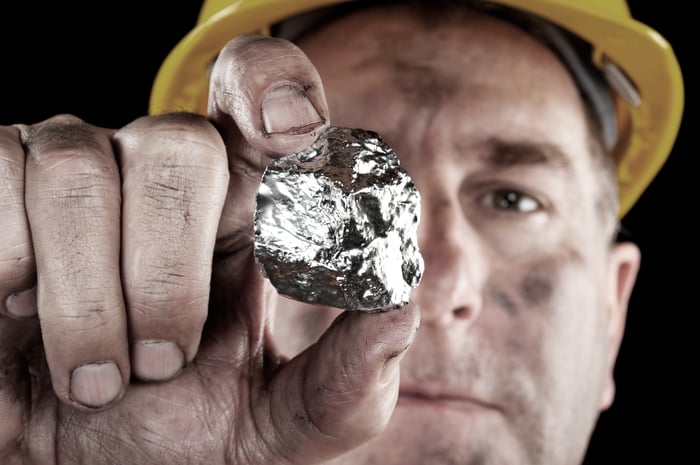Wheaton Precious Metals (WPM 0.50%) is a streaming and royalty company. It provides cash up front to miners in exchange for the right to buy silver and gold at reduced rates in the future. That locks in a profit when Wheaton sells the precious metals at currently prevailing rates. If you are looking for a precious metals investment, you should strongly consider Wheaton. But there are some factors to consider here, and tough results out of the company's silver business is a highlight on that front.
Wheaton avoids a lot of risks
Mining for precious metals is an expensive and risky thing. First, a company has to find a location where it thinks a mine can be built. Then, it needs to get permission to build that mine. After getting that OK, it has to actually build the mine. Only after it is built, usually at great expense and years later, does any revenue come in. Meanwhile, operating the mine comes with its own set of costs (salaries, for example) and potential problems (mine disasters). And, once the mine has run its course, the area has to be returned as closely as possible to its pre-mine state.

Image source: Getty Images.
There are a lot of things that can go wrong. Wheaton Precious Metals sidesteps many of these issues. It basically provides a set amount of cash up front that miners often use to help fund a mine development. That saves the miner from having to take on debt or sell stock to raise the needed cash. In exchange for the money, the miner agrees to sell Wheaton precious metals at reduced rates that effectively guarantee a profit when Wheaton sells the metal. It is pretty close to a win/win, noting that the metals Wheaton buys are often not the main metal produced by the mine.
For example, gold and silver are often found in copper mines. They are a relatively small component of the production and not the main focus of the miner, so selling these metals to Wheaton in advance isn't that big a deal. Wheaton benefits from buying it and doesn't have any financial risk beyond the initial investment it agreed to. If the mine stops producing for some reason or the production is curtailed, there will be less precious metal for it to buy, which is bad. But inflation, costs associated with adverse mine events, or employee salary issues have little to no impact on Wheaton.
Silver is a near-term problem
But, as noted, a mine stoppage will materially reduce the amount of silver and gold Wheaton can buy. That was a notable issue in the third quarter, as a 42% year-over-year decrease in silver production reduced the amount of silver that Wheaton was able to buy at reduced rates and then sell at higher spot rates. The drop came from two places -- the sale of a stream and a work stoppage at a mine. The second of those two headwinds has been resolved, but it highlights that Wheaton can't avoid all mining risks.
There's another silver headwind that is a bit more fundamental to the business. Although Wheaton gets advantageous pricing, which locks in a profit, it doesn't actually guarantee how much of a profit it will make. That's determined by the price of the metal being sold. Higher gold and silver prices generally lead to higher revenue for Wheaton. In the third quarter, silver prices were lower year over year.
Despite these two factors, silver revenue fell from $107 million in Q3 2022 to just $70 million in Q3 2023. That's a huge drop, totaling nearly 35%. Silver (about 30% of overall revenue), which was once the company's main focus, is currently a notable headwind to performance even as gold is trading near all-time highs.
The future is likely to be better
Given the resolution of the problems at the silver mine that was shuttered, Q3 is likely to be a low point for Wheaton Precious Metals' silver business. The future will brighten materially as the flow of silver from that asset picks up again. However, silver prices and the occasional hiccup at a mine can't be ignored because they can both have very real impacts on this streaming company's business. It is still a great way to add precious metals exposure to a portfolio for diversification purposes, but the third quarter shows that you can't avoid all of the risks of owning a precious metals company.





